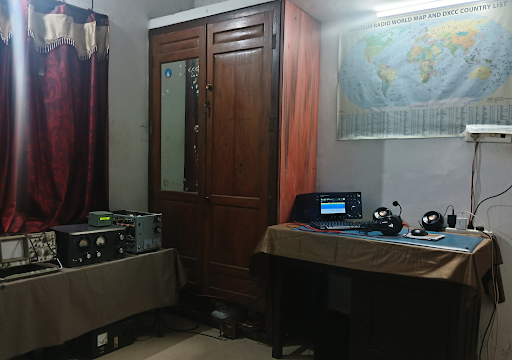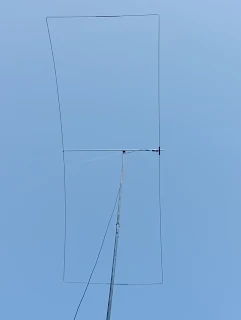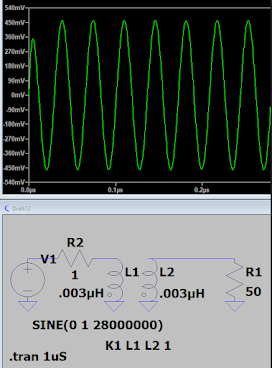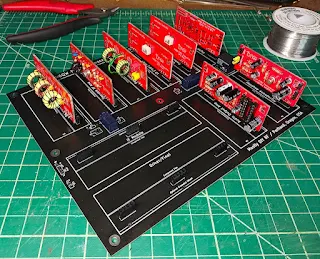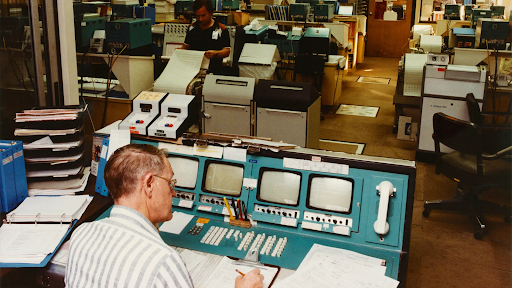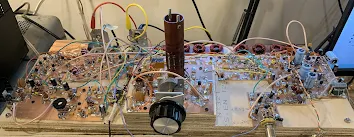Podcasting since 2005! Listen to Latest SolderSmoke
Sunday, September 17, 2023
"The Art of Electronics" Post #2 Interview with Lady Ada (Video)
Saturday, September 16, 2023
"The Art of Electronics" by Horowitz and Hill (First in a Series of Blog Posts on this Great Book)
Oh man, this book is so good. You really just need to buy it now. I put it in the Amazon link to the right.
OVER HERE >>>>>>>>>>>>>>>>>>>>>>>>>>>>>>>>>>>
The Imsai guy reminded me of this book, and pointed out that earlier editions are more reasonably priced, so I got the second edition (looks like 1980, reprinted many times through 1988). Dean KK4DAS got one too (I think he also got the second edition).
Lest there be any doubt that this book is for us, first let me point to the pictures of Paul Horowitz and Winfield Hill. https://artofelectronics.net/about/
Friday, September 15, 2023
HB2HB -- A Contact with Denny VU2DGR (video)
At first I didn't realize it was Denny. On September 11, 2023 at about 2330Z I had walked back into the shack after dinner. I think DX spots showed an Indian station on 20 meter SSB. Without realizing who it was, I tuned him in on my Mythbuster rig, heard the other station sign off, and quickly threw in my call. Denny came back to me right away, and I think both of us then realized that we recognized the call of the other station. Wow, it was Denny, VU2DGR, the Wizard of Kerala! At the time of the QSO, I didn't have my phone with me; after we spoke, I went to get it, so the video above captures part of Denny's subsequent contact. (You can also at one point hear Guapo barking.)
Denny has been running a wonderful station that combines SDR gear with and HDR tube type amplifier and a homebrew Moxon.
Here is Denny's station. The transceiver is a RadioBerry. the amplifier and power supply are on the other table.
Thursday, September 14, 2023
Building Nixie Tubes for a Hiroshima Project
Tuesday, September 12, 2023
BEZOS BUCKS ARE BACK!
With the help of several loyal SolderSmoke listeners, we finally cracked the code and figured out how to put the new Amazon Ads on the blog. You can see it on the right side of this page.
Right over here >>>>>>>>>>>>>>>>>>>>>>>>>
You don't have to buy whatever we are advertising. Just click on the SHOP NOW sign and begin your Amazon shopping there. In this way SolderSmoke will get a small commission on any purchase you make (within 24 hours of your initial click on the SHOP NOW icon).
Friday, September 8, 2023
Why Building for 10 Meters is Harder than Building for Lower Frequencies
Recently my trusty CCI EB63A .1kW amplifier has been in rebellion. On 10 meters, it now often insists on being an oscillator. It calms down nicely on 20 meters. But on 10, it has been a rebellious beast.
Why is this? Why would an amplifier that is well behaved and stable on 20 meters behave so badly on 10 meters?
I used LTSpice to explore the problem.
I looked at two ordinary wires. I gave them each a value of .003 uH. Very low. Then I joined them together in a transformer. I put a 1 volt signal into the primary and looked (in LTSpice) at how much of a signal appeared in the secondary. First, the result on 14 MHz. About 250 mV appears on the secondary.
Monday, September 4, 2023
SolderSmoke Podcast #248 -- Back from the Summer -- Spurs and Filters, S-meters, 6BA6 mania, Shirtpocket rigs, MAILBAG
SolderSmoke Podcast #248 is available for download:
Audio: http://soldersmoke.com/soldersmoke248.mp3
Travelogue: Trip to the Dominican Republic 3-9 August. Thinking about the M0NTV video on mixers...
Solder Smoke Shack South is almost done. I am thinking about workbenches, operating tables and antennas. How high should an electronics workbench be? Table height? Or workbench (woodwork) height?
My son and I went to see "Oppenheimer" Trinity test scene very cool. They wanted to see if the gadget would work!
Is the SolderSmoke blog completely archived on the WayBack Machine? Please check and let me know. Thanks.
Bill's Bench:
-- I've been working a lot of DX with the homebrew rigs: Indonesia, Australia, Japan, Hawaii. Lots of fun. 15 meters has been especially good. But the rigs still need work:
-- M0NTV's video got me to put TinySA to work. I found that output from dual banders could be improved. Spurs and harmonics. Yuck. I need more TinySA -- ordered the TinySA Ultra.
-- Allison KB1GMX helped a lot. EB63A amp was unstable, especially on 10 meters. Higher frequencies are harder! Tightened up shielding, negative feedback, and bypassing. This all helped, but I found that I needed to take the higher frequency LP filters out of the amplifier box. W3NQN filters are better, with steeper skirts and better 2nd harmonic rejections. NanoVNA proving very useful. https://www.gqrp.com/Datasheet_W3NQN.pdf
-- Also worked on the Bandpass filters for these rigs. Farhan's comments on skirts of different filter configurations. Some are "LSB" filters (with steeper skirt at the highest freq) and some are "USB" filters (with the steeper skirt at the lower frequency) See diagrams on the blog page. So I built USB new filters for 12 meters and for 10 meters.
-- Phase Noise rears its ugly head again. See blog posts.
----------------------
SHAMELESS COMMERCE DIVISION:
Mostly DIY RF getting ready to release PsssT kits. Target date: December 18, 2023 (E Howard Armstrong's birthday). https://mostlydiyrf.com/
Amazon Search box seems to have died. I can't get it back. Can anyone tell me what happened? (There seems to be "explanations" from Amazon about this, but they are written in a strange language that I cannot follow.) Something similar happened with the Google Ads on this blog page. Apparently you can't have ads both on YouTube and blogger.
But hey, there is Patreon for those who want to support the podcast and blog.
-------------------------
Pete's Bench
An S-meter for Bill?
6BA6 Mania!
QRP SSB with 6BA6
Shirtpocket rig re-build
Mailbag:
Walter KA4KXX has a great article about homebrewing in the September 2023 QCWA Journal.
Steve KC1QAY -- Has joined the CBLA. I sent him a 3579 crystal. He built a MMM and experienced JOO. And Allison KB1GMX is in his local radio club. TRGHS.
Ajay VU2TGG in Pune, India -- launching a high school receiver effort.
Denny VU2DGR The Wizard of Kerala: https://soldersmoke.blogspot.
Joe VK4BYER working with kids a remote Australian community. FB.
Todd K7ZF -- Wants to get into homebrewing. Advised him to start small.
Dean KK4DAS: Fixing Hallicrafters Worldwide RX. Ciudad Trujillo! Got question from Mark in the VWS Makers Group: HOW DOES Michigan Mighty Mite REALLY Work. See blog.
Trevor Woods -- Info on Super Islander Mark IV made in Cuba from old CFL bulbs. FB.
Bob KD4EBM sent me some great stuff: Sony SW receiver, QCX Mini. Made a CW contact with the QCX. Felt virtuous -- it is going to the DR. Thanks Bob.
Peter KD2OMV: One of the guys I worked with the ET-2 transceiver. Great to hear from him.
Armand WA1UQO Richmond area radio museum? https://www.youtube.com/watch?
Mike WN2A -- Sent me a great care package with lots of toroids. A lifetime supply! Thanks Mike!
Nate KA1MUQ got his Doug DeMaw receiver going after 38 years! FB. Been there, done that!
Tony: G4WIF Liked Valveman video about Gerald Wells. He visited him! https://soldersmoke.blogspot.
Dean KL7MA Bill talked to him on 15 SSB. He had worked Wes W7ZOI! FB!
Monday, August 28, 2023
But How Does the Michigan Mighty Mite REALLY Work?
Dean KK4DAS and I were talking to Mark, a new homebrewer. After we sang the praises of the Michigan Mighty Mite, Mark asked us a good question: How does it really work?
I guess the starting point for analysis is the Barkhausen criteria (that Pete N6QW taught us): essentially you need enough feedback to overcome losses in the circuit, and this feedback has to be in phase with the signal at the input. The MMM is clearly oscillating, so the question becomes, "How does this very simple circuit meet the Barkhausen criteria?"
Here goes:
Friday, August 25, 2023
Wednesday, August 23, 2023
Homebrew Transistors
Sunday, August 20, 2023
15 Meter Homebrew SSB Rig As Heard in Mexico City
19 August 2023. Ralph XE1RK recorded part of our QSO and played it back to me. Thanks Ralph!
I was running about 75 watts to a hex beam aimed Southwest.Saturday, August 19, 2023
Valveman -- The Story of Gerald Wells
More Ancient Technology Keeping Space Missions Alive
https://www.bbc.com/future/article/20230815-the-ancient-tech-keeping-space-missions-alive
Three cheers for software. Really.
Wednesday, August 16, 2023
Working Indonesia and Chile with new 15-10 Homebrew Transceiver
Tuesday, August 15, 2023
The Wizard of Kerala (India) -- Denny VU2DGR -- SDR and HDR
Monday, August 14, 2023
Tuesday, August 1, 2023
Voyager, Canopus, JPL, and 74xx Logic Chips from the early 1970s
"So somewhere out there in interstellar space beyond the boundary of the Solar System is a card frame full of 74 logic that’s been quietly keeping an eye on a star since the early 1970s, and the engineers from those far-off days at JPL are about to save the bacon of the current generation at NASA with their work. We hope that there are some old guys in Pasadena right now with a spring in their step."
https://hackaday.com/2023/07/31/just-how-is-voyager-2-going-to-sort-out-its-dish-then/
Sunday, July 30, 2023
Understanding Maxwell's Equations (video)
Friday, July 28, 2023
Phase Noise and the Radio Amateur
http://www.sherweng.com/documents/TermsExplainedSherwoodTableofReceiverPerformance-RevF.pdf
Phase Noise: Old radios (Collins, Drake, Hammarlund, National) used a VFO or PTO and crystal oscillators to tune the bands. Any noise in the local oscillator (LO) chain was minimal. When synthesized radios came along in the 70s, the LO had noise on it. It is caused by phase jitter in the circuit, and puts significant noise sidebands on the LO. This can mix with a strong signal outside the passband of the radio and put noise on top of the weak signal you are trying to copy. This is a significant problem in some cases: You have a neighboring ham close by, during Field Day when there are multiple transmitters at the same site, and certainly in a multi-multi contest station. You would like the number to be better that 130 dBc / Hz at 10 kHz. A non-synthesized radio, such as a Drake or Collins, has so little local oscillator noise the measurements were made closer-in between 2 and 5 kHz.
http://qrp-labs.com/qcxp/
------------------------------------
DC4KU appears to be using the crystal filter method used by Hans:
https://dc4ku.darc.de/Transmitter-Sideband-Noise_DC4KU.pdf
------------------------------------
Martien PA3AKE has done a lot of great work on this topic. See:
https://martein.home.
-----------------------------------
Sunday, July 23, 2023
First Contacts with 15-10 Rig -- Two Atlantic Crossings
I was just testing it, working (as usual at this stage) on final amplifier stability. Then I heard ON5WO calling CQ. I could not resist. I worked him, but had to use a test lead to manually key the .1 kW amplifier. Minutes later I worked OH6RM. He very diplomatically said that I had "highly unusual audio." This was probably due to earlier efforts to shift the carrier oscillator to improve carrier suppression. (I will fix this.)
I will continue to work on the rig; It should look a bit better when I am done. But hey, it works! It has already crossed the Atlantic. Twice!
Tuesday, July 18, 2023
"Onda Corta" ("Shortwave") -- A Short Film about Ham Radio in Venezuela (Please ID the Boatanchors!)
I have it cued up to 9:43 -- at that point Ramon is in his ham shack.
Monday, July 17, 2023
Going Down the Phase Noise Rabbit Hole with the IMSAI Guy (VIDEO) -- Is there a better way?
Sunday, July 16, 2023
The Super Islander Mark IV -- A Cuban DSB Transceiver Made From CFL Lightbulb Parts
Trevor Woods also sent us this report from Arnie Coro. It is not clear to me what difference (if any) there is between the Super Islander Mark IV and the Jaguey Five (described yesterday). But the bit about using parts from old CFL bulbs is interesting. This was something championed by Michael Rainey AA1TJ several years ago. See: https://soldersmoke.blogspot.com/2009/01/soldersmoke-98.html
April 2010:
Today, I will be answering a question sent by listener Bruno from Croatia... Bruno picks up our English language programs via Internet, but he is now also listening on short wave too. He sent a nice e-mail message asking me about the latest version of the Super Islander amateur radio transceiver, because he wants to build one.
Well amigo Bruno, the Super Islander Mark IV is now on the air, and results are very encouraging considering that it is a 40 meters band transceiver built using recycled electronic components.
The Mark IV uses a totally different approach to the receiver design, and it adds two solid state audio filters.
Amazing as this may sound, some of the electronic components used to make the Super Islander Mark IV transceiver came from the circuit boards of broken or damaged Compact Fluorescent Light Bulbs... and that means that there is virtually an endless supply of those parts.
Here is now amigo Bruno, and amigos listening to the program at this moment, a brief description of the Super Islander's Mark IV receiver module.
It starts with a simple resistive signal attenuator that feeds a dual tuned bandpass input filter.
The filter has a limited bandwidth , chosen so as to limit response to out of band signals... The filter is followed by a cascode transistor radio frequency amplifier stage, that feeds a broadband four diodes product detector.
Low level audio from the product detector goes to the audio filtering and amplifying module, made with discrete transistors, of which several of them are also recycled from the Compact Fluorescent Light Bulbs circuit boards...
This version of the Super Islander, the Mark IV , is radically different from any previous ones, as we have now switched over to a totally low cost solid state design , that can be easily reproduced because it uses very common electronic components and straightforward , easy to adjust circuits.
In our upcoming mid week edition I will describe the VFO, or variable frequency oscillator and the transmitter module of this unique low cost amateur radio transceiver, the Super Islander Mark IV... about the lowest possible cost transceiver that will make possible regular two way ham radio contacts on the 40 meters band using either voice or radiotelegraphy modes.
Saturday, July 15, 2023
The Jaguey Five -- The Solid State Cuban DSB Rig -- Circuit Description
Trevor Woods found this report from Arnie Coro (SK) CO2KK:
February 2009:Here is now item three in detail: It was quite a long time ago, when I heard about a nice project sponsored by IARU, the International Amateur Radio Union, that was promoting the design of a kit, a simple single band transceiver kit that could be sent in a small air mail parcel to radio clubs in Third World nations which could then deliver them to would-be radio amateurs, and help them build and align the radios... But, unfortunately I lost track of the project, and as many of our listeners may realize there is still a great need of such a project... Past efforts along this line have had some problems, among them the mistaken approach of using of very sophisticated electronic components that in case of a breakdown would be impossible to replace locally; and also, all attempts seemed to try to make the transceiver an ultra- or near-ultra-miniature radio, something that won't help at all with beginners...
So, when I recenlty received an e-mail from Canada, asking what I thought about reviving this great idea, our Canadian amigo asked what we had already done here in Cuba, with our JAGUEY double side band plus CW 10 watt transceiver that went up to REVISION NUMBER 5. , This was the last upgrade, done about three or four years ago, and we named it the Jaguey FIVE, as it generates 5 watts of CW... The Jaguey FIVE was a low parts count, not miniature, easy to build single band transceiver that used readily available components, instead of sophisticated state of the art parts...
In order to please the friend who wrote about this topic, here is a brief, on the air, description of our Jaguey FIVE and by the way, Jaguey is the name of a town, actually it is Jaguey Grande, or big Jaguey, and the Jaguey is a beautiful tropical tree... The original Jaguey transceiver originated in that Matanzas province town in 1982,
The receiver part starts with a simple yet effective RF attenuator, then it feeds a bandpass
filter made of two tuned circuits... we use shielded IF transformers from old TV sets 4.5 megaHertz audio chains... A simple bipolar NPN small signal transistor grounded base amplifier feeds a homebrew double balanced mixer... and we "discovered" quote, unquote, that the antenna balun transformers used in TV sets, the 300 to 75 ohms baluns, had a ferrite core with two holes that makes a wonderful broadband transformer for the double balanced mixer...
We use computer diodes removed from defunct ISA old computer cards and motherboards and developed a very simple test jig to match the diodes... The double balanced mixer is fed on the other port from a simple three transistor oscillator, of which we have two versions, one using three NPN bipolar transistors and the other one using an FET oscillator followed by two bipolars... at the output of the mixer we have AUDIO, as this is a direct conversion receiver, amigos!!!
Now we amplify the audio using discrete components and again we have two versions of audio filters, one with bipolar NPN transistors and the other using a very common operational amplifier IC... The audio power output stage also is available to the builder in two versions, one using discrete components and the other using an integrated circuit audio amplifier that is locally available here in Cuba and produces a booming 2 watts of audio, with a lot of gain and rather low noise! This is the audio IC used by the most popular TV set in use here in Cuba, so we were able to obtain them from the TV repair shops at low cost.
Well, that's why I will describe as a flexible design... again, no attempt is made to make the Jaguey single band amateur transceiver a miniature rig, as miniaturization is definitely not for beginners!!! And following up this description of the receive section of the Jaguey, in our upcoming mid-week edition of Dxers Unlimited, I will describe the transmitter section of the rig,that shares the same variable frequency oscillator with the receiver.... I think that a new more up to date version of the Jaguey transceiver could very well be made available in kit form, with large-sized and easy to assemble circuit boards. The old Version 5 uses three circuit boards, one for the receiver, one for the VFO and one for the transmitter, so the newcomer can assemble just the receiver and start listening to amateur radio communications before having his or her own ham license!!!
You are listening to the weekend edition of Dxers Unlimited coming to you from Havana on the air and on the web at our Dxers Unlimited blog.
----------------------
A video of Jaguey Grande, Cuba: https://www.youtube.com/watch?v=krblz_5o6jU
Earlier posts about the Jaguey on the SolderSmoke blog: https://soldersmoke.blogspot.com/search?q=Jaguey
Tuesday, July 11, 2023
Homebrew in Namibia -- Joe Noci V51JN -- -- The Wizard of Sawkopmund
Joe recently posted on the Amateur QRP Radio Facebook group:
I am not on the air much - here in Swakopmund ( Namibia) we have quite bad RFI from mains borne RF control signals for geysers, pumps, etc and 40M is unuseable, 30M almost usable and 20M sort of useable.. Complaint to CRAN - Our Radio Ministry - achieve nothing...So I do mobile out in the desert in the 4X4 when I can! I enjoy building radios - here are some photos - first is a 5watt 7MHz to 21MHz all band SSB rig - all homebrew, inc crystal filters, etc. PA is a push-pull LDMOS amp, 5W PEP.
Monday, July 10, 2023
Martein's Bandpass Filters - PA3AKE
Before I built Martein's filter, my bandpass had been inadequate. Looking at the signals coming out of the diode ring mixer in my 15-10 rig, I realized that when I was on 15, there would also be an output on 10. And vice-versa. These outputs would have to be knocked down by the bandpass filters. I had been using simple dual tuned circuit filters. But when I looked at the filter shapes of these filters in NanoVNA, I could see that On 15 the 10 meter signal was only down about 20 db. And on 10 the 15 MHz output was also down only by about 20 db. That's not enough. Take a look:
Sunday, July 9, 2023
Progress Report Video on my 15-10 Meter Homebrew SSB Transceiver
Thursday, July 6, 2023
The TEK 465 'Scope Used to Create Pong and the Apple II







